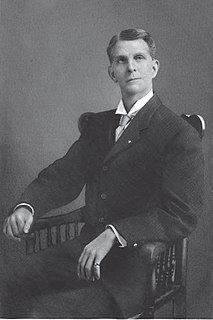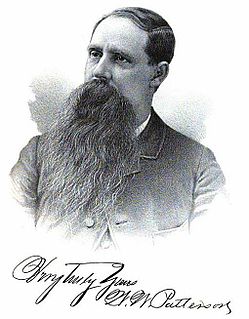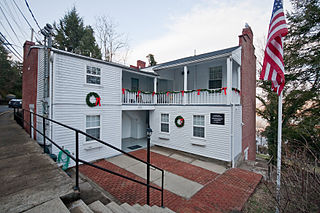
Maysville is a home rule-class city in Mason County, Kentucky, United States and is the seat of Mason County. The population was 8,782 as of 2019, making it the 51st-largest city in Kentucky by population. Maysville is on the Ohio River, 66 miles (106 km) northeast of Lexington. It is the principal city of the Maysville Micropolitan Statistical Area, which includes Mason and Lewis counties. Two bridges cross the Ohio from Maysville to Aberdeen, Ohio: the Simon Kenton Memorial Bridge built in 1931 and the William H. Harsha Bridge built in 2001.

Liberty Hall is a historic house museum at 218 Wilkinson Street in Frankfort, Kentucky. Built 1796-1800 by American statesman John Brown, it was designated in 1971 as a U.S. National Historic Landmark for its association with Brown and its fine Federal-style architecture.

William Hopkinson Cox was an American politician, who served as the 30th Lieutenant Governor of Kentucky from 1907 to 1911, under Governor Augustus E. Willson.
Washington is a neighborhood of the city of Maysville located near the Ohio River in Mason County in the U.S. state of Kentucky. It is one of the earliest settlements in Kentucky and also one of the earliest American settlements west of the Appalachian Mountains. It played a significant role in the lead-up to the Civil War, producing two civil war generals and an escaped slave whose legal case established Canada as a safe haven for escaping slaves. It also provided the site where Harriet Beecher Stowe witnessed a slave auction. It has since been annexed by Maysville, and is sometimes now referred to as Old Washington. The community is in Area 606 served by the 759 exchange.

The Washington Historic District in Washington, Kentucky was listed on the National Register of Historic Places in 1970, and its borders were increased in 1976. The buildings of Washington range from simple log cabins to late Georgian and early Federal styles constructed of home burned brick laid in Flemish Bond. Many houses have double doors at the entrance and a reeded roll length wise under a four light transom.

William Worth Patterson was a Kentucky businessman, the sixth Mayor of Ashland, Kentucky (1886–1889), and the Division Inspector of the Post Offices in Denver (1889–92).

Armstrong Row is a series of 11 brick row houses in Maysville, Kentucky built between 1820 and 1833 by John Armstrong, a local industrialist, entrepreneur and real estate developer. Vacant lots were purchased by an Armstrong owned company that operated the Maysville cotton mill. The company continued to operate as the January & Wood Company until 2003. Armstrong also developed a number of other row house projects in Maysville including the Federal style row houses on Limestone Street, Mechanic's Row, and the "Allen Block".

Phillips' Folly is an historic three-story brick residence in Maysville, Kentucky. The home's Antebellum architecture displays a blend of styles which may be explained, in part, by the home's speculative six-year construction period, which ended with its completion in 1831. The Sutton Street entrances are Federal, windows are typical Greek Revival in their size and character, and the two-tiered portico and the segmental dormers reflect a Georgian influence. The portico and Doric frieze are similar to Drayton Hall (1738–42) near Charleston, South Carolina. The stepped parapets on the end walls are peculiar to the Ohio River Valley and are "associated with the 'Dutch' character of Cincinnati, Ohio and the surrounding area." The home also possesses an artful and unique dry stacked foundation that is set without mortar.

The John Brett Richeson House in Maysville, Kentucky was built in 1832 and purchased by John Richeson, an educator from Charlottesville, Virginia, for his wife Mildred Richeson and their eight children. The house was occupied by the Richeson family for more than 100 years until the death of Edward Richeson in 1941.

Point Au View is an Italian villa architecture house located in Mason County, Kentucky. It was built in the 1850s for Judge Emory C. Whitaker, a prominent Maysville lawyer. Whitaker was born in New Hampshire in 1816 and moved to Kentucky in 1841. In 1849, he was elected to represent Mason County in the lower house of the Kentucky state legislature. He was elected Mason County Judge in 1853 and served for eight years.

The Old Library Building was chartered by the Maysville and Mason County Library, Historic and Scientific Association in 1878 and built between 1878 and 1880. It is the last of four libraries established in Maysville, Kentucky in the nineteenth century. It was preceded by the Maysville Lyceum – chartered in 1839, the Maysville Athenaeum – 1840, and the Maysville Library - date unknown, but no longer in existence by 1859.

The Newdigate-Reed House is a two-story log house built by the Newdigate family at the top of the hill near the Lexington-Maysville Turnpike. John Newdigate, a farmer, is listed as the landowner in 1854. Situated at the top of a steep hill leading out of Maysville, the house served as a convenient rest stop for merchants and wagon masters hauling goods from the docks at Maysville to points south.

The Joseph H. Frisby House is a historic house located at 209 North 400 West in Provo, Utah. It is listed on the National Register of Historic Places.

The Heber Hord House is a two-story frame house in Central City, Nebraska. It was designed by Omaha architects Fisher and Lawrie, and built in 1906 by Heber Hord, the only son of Thomas Benton Hord, a prominent business man and cattle rancher in Nebraska during the late 19th and early 20th centuries. It is listed in the National Register of Historic Places.

The Ivinson Mansion, now the Laramie Plains Museum, was built in 1892 in Laramie, Wyoming by Jane and Edward Ivinson. Designed by architect Walter E. Ware of Salt Lake City and built by local contractor Frank Cook, the house was regarded as the most significant residence in Laramie at its completion. Edward Ivinson gave the mansion to the Episcopal Church, which used it as a boarding school until 1958. After years of neglect, the house was acquired by the Laramie Plains Museum Association in 1972 and is used as a museum and events center.
The Maysville Historic District is a historic district in Mobile, Alabama, United States. The district covers 451 acres (183 ha) and contains 1121 properties located southwest of downtown and directly south of the Leinkauf Historic District. Platted in 1871 in the midst of a recession in Mobile, the neighborhood did not begin to develop until the late 1890s. Maysville has long been a working class neighborhood; many late 1890s and early 1900s houses were bungalows and cottages, some with modest Victorian influences. Some larger and more decorated houses were built in the northeastern portion of the neighborhood. In the early 20th century and into World War I and World War II, the Port of Mobile and its shipyards became a focus of Mobile's economy, and the population grew in response. The early 20th century saw many craftsman-style bungalows and four square houses built. Minimalist Traditional and some ranch-style houses became popular around and after World War II. Notable contributing buildings in the district are Ladd–Peebles Stadium, built in 1948, and Williamson High School, built in 1965. The district was listed on the National Register of Historic Places in 2013.

The Criffield-Whiteley House is a private house located at 601 Main Street in Dowagiac, Michigan, United States. It was added to the National Register of Historic Places in 2016 and was designated a Michigan Historic Site in 2019.
Oscar B. Hord was an American politician and lawyer who served as the sixth Indiana Attorney General from November 3, 1862 to November 3, 1864.
Francis Triplett Hord Jr. was an American lawyer, politician, and judge who served as the thirteenth Indiana Attorney General from November 6, 1882, to November 22, 1886.

















